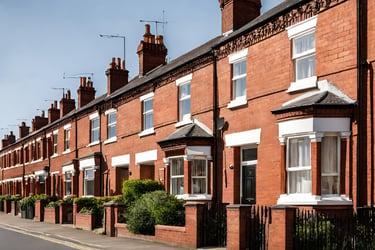How To Get Started With Social Housing Investing
Discover how to start investing in social housing. Learn about lease types, property choices, finance options and key tips for a hassle-free investment.
SOCIAL HOUSING
Seven Generations Property Brokers
8/27/20258 min read


Investing in social housing is quietly becoming one of the more stable, hassle-free routes for buy-to-let investors. While traditional buy-to-let models face rising costs, not to mention legislative pressures and unpredictable tenants, investing in social housing offers something increasingly rare: fixed income with long-term contracts and fully managed properties.
That said, it’s not a one-size-fits-all model. Getting started requires an understanding of several aspects, including the lease structures and finance options, as well as your preferred investment type.
We cover what you need to know about social house investing, along with what to watch out for before getting started.
Contents


Get in touch with one of the team to discuss what properties we have available for sale.
Interested in Social Housing HMOs?
1. Choose the right property type and lease model
Investing in social housing is an alternative to traditional buy-to-let, but not all social housing investments are created equal. The type of property and lease you choose will shape everything from your returns to your level of involvement.
Houses or HMOs vs apartments
Freehold houses and HMOs are generally the preferred route. They’re simpler to manage, and don’t tend to carry service charges. Many investors find them more appealing to social housing providers. You also avoid common issues tied to leasehold flats, be it ground rent clauses and service charges that can eat into yield.
Apartments are less common in social housing models aimed at vulnerable groups. They’re harder to adapt to occupancy needs and often come with limitations around structural changes, something providers may require as part of their lease criteria.
Different types of leases: social housing vs supported or assisted living
Social housing investing typically involves a contracted lease to a provider supporting individuals who struggle to access private rental housing for financial or social reasons. That includes ex-offenders, asylum seekers, domestic abuse survivors and others classed as vulnerable adults.
Leases usually last five to seven years, with the provider taking on full responsibility for rent payments, property management and occupant supervision. That means you earn rent whether the property is occupied or not and don’t have to be involved in the day-to-day running of the property.
Supported living and assisted living often involve more specialist care or facilities in the property. These may generate higher returns but come with added complexity and fewer turnkey options for retail investors.
By contrast, council-commissioned affordable housing is rarely available to individual landlords and is usually handled via institutional contracts or large-scale housing associations.
Location Matters
Social housing demand is strongest in the Midlands, the North West and other regions where lower property prices make government-funded housing more viable. For instance, the North West has seen a 39.1% increase in social housing waiting lists between 2000 and 2022.
Providers need to balance housing costs with funding caps. Therefore, high-value areas like London are rarely viable. Even within high-demand regions, however, availability can shift.
Local authority restrictions often limit the number of social housing properties that can be active in a single area. Once a postcode reaches capacity, providers stop issuing leases there. Because the data isn’t made public, it’s difficult to plan unless you're already working with a developer or property agent who has access to current lease allocations.
If you're looking at HMOs, be aware of Article 4 areas, where planning permission is required to convert homes into HMOs. Many larger cities, including Manchester, Leeds and Birmingham, have these restrictions in place, which can delay or block your investment plans if not considered early.
2. Turnkey vs DIY: which approach suits you best?
When it comes to getting started with social housing investing, you’ll need to decide whether to go for a fully packaged investment or take on the sourcing and setup yourself.
Turnkey social housing investments
The most popular route for hands-off investors is turnkey, a property that’s already been renovated, inspected and leased to a provider before you buy it. That means:
The lease is already signed
Rental income begins the day you complete
All compliance work is done
You skip the risk and costs of failing to secure a provider lease
The upside is faster time to income and less uncertainty. There is a trade-off however. You'll have less flexibility on property type, location and price. Turnkey investments are often sold at a premium, which reflects the lower risk.
DIY (source, convert and lease it yourself)
A DIY approach gives you more control. You buy a property and complete any refurb or conversion work to meet provider standards. You also negotiate the lease directly. If done well, you might secure better ROI and add capital appreciation through any refurbishments
But it’s not straightforward, as many providers won’t sign a lease until all work is complete. Even then, there’s no guarantee they’ll proceed. You’ll also need to handle planning, licensing, lease negotiation and inspections yourself. It’s a good option if you're experienced and well-networked, but it may provide a steep learning curve for first-time investors.
3. Understand the lease before you buy
Not all social housing leases are created equal. Before you commit to a property, you need to know exactly what’s in the contract. Look out for:
Lease length: Most range from three to 10 years. Some include break clauses as early as year three.
Break clauses: Check when the provider can terminate, and under what circumstances.
Repairs and maintenance: Many providers cover these, but the terms vary. Boiler cover, white goods, structural repairs? Check the small print.
Payment schedule: Is rent paid monthly in advance or arrears? When does the first payment land in your account?
Provider credibility: Larger providers like Serco, Mears and Nacro tend to offer more stability.
Mortgage suitability: Not all leases are mortgage-friendly. If you plan to finance, the lender will want to see the lease before agreeing to terms.
Working with a property specialist makes a real difference, as they’ll help you understand what’s covered and what isn’t. That way, you can see if the deal aligns with your goals.
4. Budget and Finance Options
Knowing your budget early will help avoid delays later down the line, especially as finance options for social housing investments can be more limited than standard buy-to-lets.
Typical turnkey properties start around £175,000, though larger HMOs can go above £300,000 depending on the yield and lease terms.
Most turnkey options are cash-only purchases, with the option to secure financing after. At Seven Generations Property Brokers, we work with social housing investments that can be purchased with a buy-to-let mortgage and we can help you through the process from start to finish.
If you're intending to finance the purchase, a handful of lenders do allow mortgages on social housing leases, but you’ll need to work with a property agent and mortgage specialist who understands the market.
Expect lower loan-to-value ratios (60–70%) and slightly higher interest rates than standard BTL products.
Upfront costs to budget for include:
Deposit (30-40%)
Solicitor fees
Mortgage broker and loan arrangement (product) fees
Stamp Duty Land Tax
If you’re going down the DIY route, you’ll need cash for the purchase, refurbishment, compliance checks and potentially one to three months of holding costs before the lease kicks in.
Bridge-to-let or refurb-to-term mortgages are possible, but only if your end lender accepts social housing leases. Not all do, and refinancing without checking lease compatibility could leave you exposed to mortgage fraud.
Make sure to factor in:
Cost overruns
Delays in snagging or inspections
Council licensing fees (especially for HMOs)
Bridge interest or holding costs if lease delays occur
5. What happens when the lease starts?
In most turnkey models, the lease is already live. Once you complete the purchase, the developer arranges the lease transfer to you, and rent is paid from that point forward (typically on a monthly basis, with the first payment pro-rated).
You’ll need to:
Fill in your landlord account setup forms
Confirm your payment details with the provider
Understand when the first full payment will arrive (usually end of the following month)
In DIY cases, the lease doesn’t start until all works are complete and the provider has signed off the property. You’ll need to schedule:
Final inspections by the provider and any remedial works
Compliance checks (gas, electric, EPC, fire safety and HMO license if applicable)
Lease signing and onboarding process
It can take several weeks after refurb to go live. Allow a one to three month buffer between completion and rental income, depending on the provider’s timeline and whether re-inspections are required.
6. Who you’ll work with
Whether you opt for turnkey or the DIY approach, getting the right people around you can make or break your social housing investment, especially when specialist leases and compliance are involved.
The developer or property agent usually manages everything in a turnkey situation: the refurb team, project manager, lease negotiations and even solicitor recommendations if needed. Your main contact is often a property broker or agent.
You can still choose your own solicitor, if you do, choose someone experienced in buy-to-let and commercial leases and confirm that they have experience with these types of leases.
If you're sourcing and leasing yourself, you’ll need to manage the builders and contractors, as well as planning consultants (if Article 4 or full planning is needed). Beyond that, you’ll be required to handle lease negotiations with the provider and find a solicitor who understands corporate leases.
A mortgage broker with access to specialist lenders will be essential, especially as the margin for error is much higher – and the timeline much longer – if you’re coordinating it all yourself. Make sure they fully understand the lease terms and service user profile, this is often where mortgage brokers fall down with this type of lending.
7. Which route is right for you?
Whether you go for turnkey or DIY comes down to your goals and how involved you want to be. A turnkey route suits investors who value lower risk, simplicity and speed. You’re buying a property that’s already income-producing, with the lease in place and management taken care of.
It’s typically an easier path to cash flow, especially if you’re short on time or want a more passive approach. You’ll still need a deposit for the mortgage and a reliable solicitor, and you should check the lease terms, particularly if the net yield is below 8%, as that can quickly erode returns.
DIY investors, on the other hand, tend to be more hands-on. They often have some property experience already or are prepared to manage the moving parts involved in sourcing, refurbishing and leasing a property themselves.
It’s a slower start and usually comes with a higher upfront cost and risk, but there’s potential for better long-term returns and more control over the process.
That said, it’s not the right fit for everyone. If you’re new to social housing investments or working with limited time, the complexity and coordination required can become overwhelming fast.
8. How Seven Generations Property Brokers can help
While we only work with turn-key social housing investments for sale, our property brokers have a deep knowledge around this area and if you’d like help weighing up which route suits your goals, get in touch.
If the turn-key route is more suited to what you’re looking for, we’ll walk you through what’s available and what to expect, so you can make an informed decision that works for you.
Registered Company Number: 15439671
Seven Generations UK Limited
Copyright © 2025 Seven Generations UK Limited, All Rights Reserved
PRS Membership Number: PRS043981
